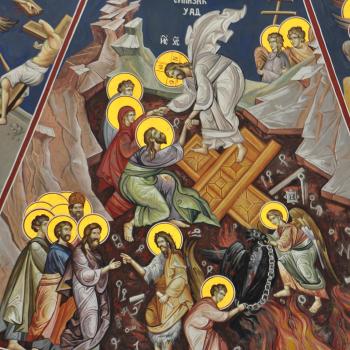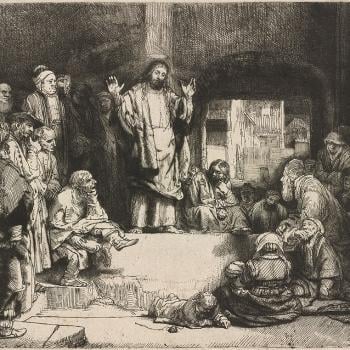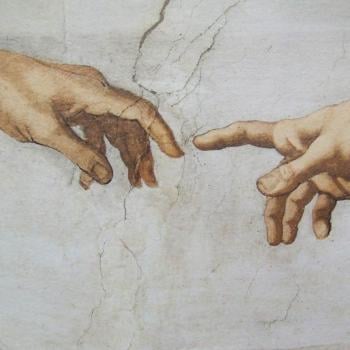![By anonimus (http://days.pravoslavie.ru/Images/im2463.htm) [Public domain], via Wikimedia Commons](https://wp-media.patheos.com/blogs/sites/637/2016/08/hymns-1-226x300.jpg)
A mediator is someone who represents two different parties. To say Jesus is the sole mediator between God and man does not say there are no mediators between Jesus and us. It is indicative, as we have seen, of the way only Jesus in his person, brings together divinity with humanity, restoring the original relationship between the two.
When we pray for one another, when we evangelize, when we seek bring God’s healing justice to the poor and needy, we are also acting as mediators for Jesus Christ to the rest of the world. We represent Jesus to the world, and yet encourage and bring the world to Jesus, seeking to establish a union of the two. By such mediation, we are not doing the special, unique soteriological work of Jesus. Instead, we are relying upon it, bringing what it has established into the world. If we were to assume that Paul, in writing to Timothy, wanted us to think we would not be co-mediators working with and under Jesus, he would not ask us to do any form of mediation. Scripture would not tell us to evangelize, to reveal the Gospel to others, and yet Jesus himself was the one who told us to go out into the world, baptizing the nations (cf. Mk. 16:15). And if we read Paul carefully, he understood that his own suffering was able to help in mediating the work of Christ to the church: “Now I rejoice in my sufferings for your sake, and in my flesh I complete what is lacking in Christ’s afflictions for the sake of his body, that is, the church” (Col. 1:24 RSV). It is not that Paul believed Christ’s work was insufficient, but that it had to be mediated by us to the world: grace is sufficient, but God chose us to be used as instruments in which that grace is mediated to the rest of the world. Our work differs between what Jesus did; our intercession and work relies upon and uses the unique mediation of Jesus, and without his work, ours could not be done.
All of what has been said about mediation, and the different forms of it, serves as the basis for our understanding of the Marian title Mediatrix of All Graces. We must understand that it is not saying she mediates grace like Jesus did in the incarnation. Rather, its purpose is to present to us the special role, the special form of mediation, she has been given because she was chosen to be the Mother of God. Through her, Jesus was born. She connects Jesus to us; she is the one who gave Jesus his humanity by giving a part of herself, her own flesh, over to him. So it is through her that Jesus is able to affect our salvation and to be the sole mediator between God and man. Mary is the unique gate between Jesus and us as St. Anthony of Padua explained:
The third book of Kings says of this admirable work, that Solomon carved on the doors of the temple cherubims and figures of palm-trees and reliefs [cf. 3(1)Kg 6:32]. Blessed Mary is the gate of heaven and the door of paradise. On her the true Solomon has engraved ‘cherubim’ (the angelic life and the fulness of charity), ‘palm-trees’ (which stand for victory over the enemy, the evergreeness of perseverance and the heights of contemplation), and ‘reliefs’ (outstanding heavenly qualities, humility and virginity).[1]
In this way, then, she can be said to mediate all graces, not because she is the actor who accomplished our saving mediation, but she was the means by which that actor came to the world stage in order to accomplish his act with us. In her special form of mediation, we note that Mary uniquely unites herself to the work of Christ because of the way she gave her flesh over to him in order for him to become man. While God could have chosen another way to achieve his end, he chose the most fitting and best way, and Mary was forever a part of his eternal choice as the way the incarnation would be achieved. Having chosen her for this task, she has become his mother who will always be with him, always having a special place next to him, which is where she is even now, interceding for us, mediating his graces for us when we ask for such help:
But, since Divine Providence has been pleased that we should have the Man-God through Mary, who conceived Him by the Holy Ghost and bore Him in her breast, it only remains for us to receive Christ from the hands of Mary. Hence whenever the Scriptures speak prophetically of the grace which was to appear among us, the Redeemer of mankind is almost invariably presented to us as united with His mother. The Lamb that is to rule the world will be sent – but He will be sent from the rock of the desert; the flower will blossom, but it will blossom from the root of Jesse. Adam, the father of mankind, looked to Mary crushing the serpent’s head, and he dried the tears that the malediction had brought into his eyes. Noë thought of her when shut up in the ark of safety, and Abraham when prevented from the slaying of his son; Jacob at the sight of the ladder on which angels ascended and descended; Moses amazed at the sight of the bush which burned but was not consumed; David escorting the arc of God with dancing and psalmody; Elias as he looked at the little cloud that rose out of the sea. In fine, after Christ, we find in Mary the end of the law and the fulfillment of the figures and oracles.[2]
As Mediatrix, we recognize how she becomes our spiritual mother, connecting us to Christ. Her life, her work, was all related to Jesus. She served him in love, his perfect feminine complement. While Jesus is the God-man, uniting earth to heaven, she is the representative of humanity who gave a free and perfect yes to God, so that humanity, embracing God in her, can be taken up by Jesus and raised up in glory. She mediates the yes of humanity to Jesus. All the good which remained within humanity after the fall was brought together in her, which she then offered up to God. The gift was accepted, and Jesus, God the Son, assumed it unto himself and made it his own so that we can say with Hans Urs von Balthasar: “Her cooperation, the work of her who serves both as a woman and as a creature, is not forgotten: it is integrated into his.”[3]
[1] St. Anthony of Padua, Sermons for Sundays and Festivals. Volume III. trans. Paul Spilsbury (Padova: Messaggero di Sant’Antonio, 2009), 395.
[2] St. Pius X, Ad Diem Illum Laetissimum, Vatican Translation, ¶6.
[3] Hans Urs von Balthasar, Theo-Drama III. Dramatis Personae: Persons in Christ. trans. Graham Harrison (San Franciso: Ignatius Press, 1992),351.
Stay in touch! Like A Little Bit of Nothing on Facebook:
A Little Bit of Nothing













